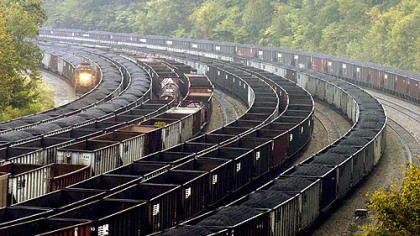W.Va. study unearths higher health risks in coal mining communities
Share with others:
People who live in counties where lots of coal is mined are much more likely to suffer from an array of chronic, life-threatening health problems, according to a new study published in April's American Journal of Public Health.
The study, "Relations between Health Indicators and Residential Proximity to Coal Mining in West Virginia," found that in the 14 counties where the biggest coal mining operations are located residents reported higher rates of cardiopulmonary disease, chronic obstructive pulmonary disease, hypertension, diabetes, and lung and kidney disease. In each of those counties, mining topped 4 million tons of coal a year.
"Residents of coal mining communities have long complained of impaired health. This study substantiates their claims. Those residents are at an increased risk of developing chronic heart, lung and kidney diseases," said Dr. Michael Hendryx, associate director of the Institute for Health Policy Research in West Virginia University's Department of Community Medicine and lead author of the study.
The study, which analyzed existing data in a 2001 West Virginia University health survey of 16,493 West Virginians in 26 counties where coal is mined, found that residents of coal mining communities have a 70 percent increased risk for developing kidney disease; a 64 percent increased risk for developing chronic pulmonary disease like emphysema; and are 30 percent more likely to report hypertension.
Dr. Hendryx said the study's finding can be generalized beyond West Virginia's borders, based on other work he's done on hospitalization patterns in West Virginia, Pennsylvania and Kentucky, and mortality rates in eight Appalachian coal field states.
According to the Centers for Disease Control and Prevention, Dr. Hendryx said, mortality rates have been consistently higher in coal mining areas compared to other areas of Appalachia and the nation since 1979, when the centers began tracking that data.
Dr. Steve Ostroff, director of the Bureau of Epidemiology at the Pennsylvania Department of Health, said the West Virginia University study presents an interesting hypothesis that both requires and deserves further study.
"The paper demonstrated a potentially important relationship between health outcomes and location near a coal mine, but it doesn't prove a cause," said Dr. Ostroff. "It's an interesting finding, an important finding, but before you can take it to the bank you need to do a lot more study."
He said academics will need to do that additional work because the state health department doesn't have the resources to do it yet, though it has received funding from the CDC to establish an environmental health data base for the state.
In Pennsylvania, Armstrong, Greene, Indiana and Somerset counties had mining operations that dug more than 4 million tons of coal in 2006, the latest year for which records are available from the state. Mining operations in Clearfield, Elk and Washington counties dug more than 3.4 million tons each.
Greene County mines were by far the biggest producers, pulling out almost 42 million tons annually. In 2005, for example, Greene County residents had a bronchus and lung cancer rate of 86.9 per 100,000, much higher than the state average of 70 per 100,000. But that doesn't prove that mining was the cause of those cancers.
Dr. Hendryx's latest findings -- which take into account and adjust for variables of age, income, education, county poverty rate, smoking rate and obesity rate -- make a case for mining's negative health effect on both men and women who live near surface and underground mining operations.
"The vast majority of miners are men, but we found that negative health effects are still present for women," he said, "and in some cases they are even greater."
Dr. Hendryx said people living near mining operations may be exposed to and inhale dust from surface mining operations, coal preparation and cleaning plants and truck and train loading facilities. Another exposure pathway may be the chemically treated water used to wash the coal and then discharged into surface waters or injected into groundwater.
The geographic links between surface mining operations and health problems are stronger than those for deep mining, but Dr. Hendryx said they are still significant for both. About 43 percent of the mining in West Virginia is classified as surface mining, which includes so-called "mountaintop removal" mining, an increase from 19 percent in 1982. Pennsylvania's mining has shifted away from surface mining in recent decades and most of the tonnage now comes from deep longwall mining operations in Greene County, in the state's southwest corner.
Dr. Hendryx, who co-authored the latest study with Dr. Melissa Ahern of Washington State University, said he will follow up on its findings by sampling air and water quality in mining communities and determining if those differences can be traced to the mining operations.
"People in coal mining communities need better access to health care, cleaner air, cleaner water and stricter enforcement of environmental standards," he said. "Our study helps open the door for further explorations of community health and coal mining. We owe it to people in those communities to start protecting and repairing their health."
First Published April 2, 2008 12:00 am














